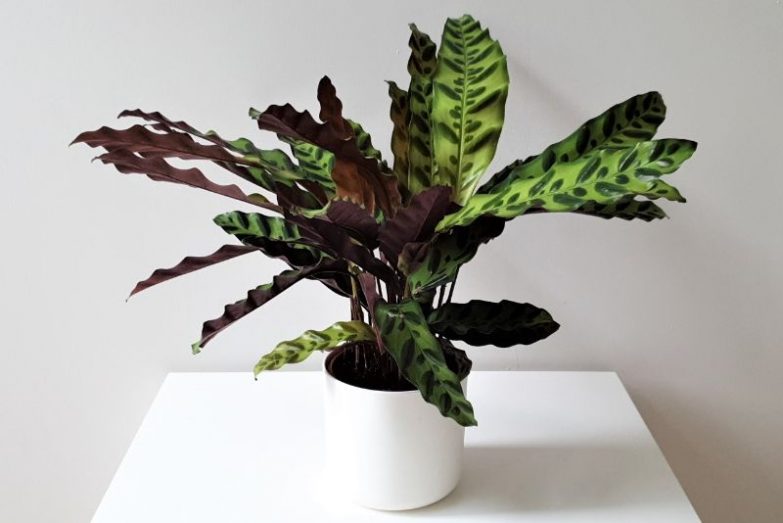Calatheas are some of the most beautiful houseplants, and it’s hard to resist bringing them home. However, they have a well-earned reputation for being fussy plants, prone to all kinds of problems. If you think your Calathea is dying, don’t dispair, as I can show you exactly how to fix your plant, and also keep it in perfect shape year after year.
The most common cause of a Calathea dying is overwatering, leading to root rot. Keep the soil lightly moist, rather than soggy. Other common causes of a Calathea (Goeppertia) houseplant dying are low humidity, pests, temperature stress, and underwatering.
This article is going to help you fix your dying Calathea. I’ll show you how to identify the problem, and what steps to take to nurse your plant back to health. I’ll also tell you a few simple tips to keep your plant in perfect condition.
Why Is My Calathea Dying?
Calatheas, (officially called Goeppertia now) originate from the tropical forests of South America. In their natural habitat, they enjoy consistently moist, highly humid conditions and temperatures that are quite consistent all year round. Calatheas have never had to adapt to diverse conditions in their natural habitat, so tend to struggle when presented with imperfect conditions.
If you want to find out why your Calathea is dying, all you need to do is examine your plant closely and think about the conditions it has been kept in recently.
I’ll go through each of the common reasons that lead to a dying Calathea, explaining the symptoms to look for and how to fix each problem. This should help you work out exactly what is wrong with your plant, and help you nurse it back to health. Let’s get started!
1. Overwatering
Calathea (Goeppertia) houseplants have delicate roots, that need constant access to lightly moist conditions to supply your plant with enough water to thrive. However, roots also need oxygen to survive, and waterlogged soil prevents root aeration and leads to sickly roots.
Waterlogged soil also promotes the growth of anaerobic bacteria, which just love to attack weakened Calathea roots. This leads to root rot, and without roots, your Calathea is in deep trouble.
Look for the following signs that overwatering is the cause of your Calathea dying;
- Yellow leaves – usually lower leaves, but can spread to more and more of the plant as things get worse.
- Brown leaf tips – If root rot sets in, the leaf tips will be the first to suffer and die, turning brown.
- Wilting foliage, despite the soil being wet.
- Curling leaves – The leaves curl to try to conserve water due to the poorly functioning roots.
- An offensive smell coming from the soil around your Calathea – this is a sign of root rot.
- The soil stays wet for a long time after watering – If the soil still feels very wet for more than 5 days after watering, the risk of overwatering and root rot is high.
- Your Calathea is in a pot that is too large – The soil will take much longer to dry out after watering, leading to prolonged soggy conditions
- The pot has few if any drainage holes.
- The soil is poorly draining – If the water sits on the top of the soil for more than a few seconds after watering, this is a problem.
- Your plant is in low light – A Calathea in low light will grow slowly and have greatly reduced water requirements, leading to soil that stays wet for longer after watering.
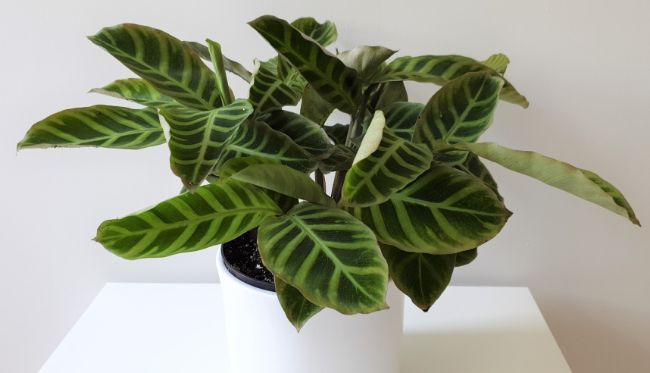
How To Fix A Calathea Dying Due To Overwatering
Here are the steps I have successfully used to fix Calatheas dying due to overwatering and root rot;
- Gently remove your Calathea from its pot and inspect the roots for signs of rotting.
- Using sterile pruners or scissors, remove all roots that are showing signs of rot, leaving only healthy roots. Rotten roots will be black/brown, fragile, mushy, and will likely smell bad.
- Gently remove the soil from around the healthy roots. I like to manually remove most of the soil and then rinse the remainder off with water.
- Optional – Dip the roots in a dilute solution of hydrogen peroxide or sprinkle them with cinnamon powder. Both of these will help to deal with any remaining harmful pathogens.
- If you have had to prune a lot of the roots, prune back the foliage by a similar amount. The reduced amount of roots won’t be able to support all of the foliage. Prune older, or damaged foliage in preference to healthy foliage.
- Repot your Calathea in a pot that just big enough for the plant. Use a well-draining potting mix. I like to use 2 parts of houseplant potting mix and one part perlite. See my article on making or buying houseplant potting mix for more info.
- Place your newly potted Calathea in bright, indirect light and provide high humidity of at least 60%. Water lightly, so the soil is moist but not soggy. Check the soil every day or two, and keep the soil consistently moist.
Your Calathea will likely spend at least 1-2 months growing new, healthy roots before producing any new foliage. Have patience. If you provide good growing conditions, there is a fair chance your plant will recover.
I recently revived a Calathea zebrina using exactly this method. I lost 2/3 of the roots and 3/4 of the foliage, but the plant recovered fully. By the following year, my Calathea was thriving and looked even better than before.
2. Pests
In terms of things that can result in your Calathea dying, pests are the second most common problem. Spider mites are a particular problem and can severely damage your plant before you even spot the problem.
Thrips and mealybugs also like Calatheas and can do a lot of damage. Fungus gnats seem to like Calatheas but are much less harmful to your plant.
Check for the following things to see if pests are the cause of your Calathea dying;
- Look for irregular yellow or brown spots on the leaves or holes in the leaves.
- Check the top and underside of each leaf, as well as along and between the stems for any pests.
- Look really closely for fine wispy webs that indicate spider mites. Look really closely and you might see the tiny critters – they are tiny white or red/brown dots no bigger than a pinhead.
- Check the soil surface for any signs of pests or their larvae.
- Check for irregular loss of color of the underside of the leaves. This is often the most visible early sign of spider mites.
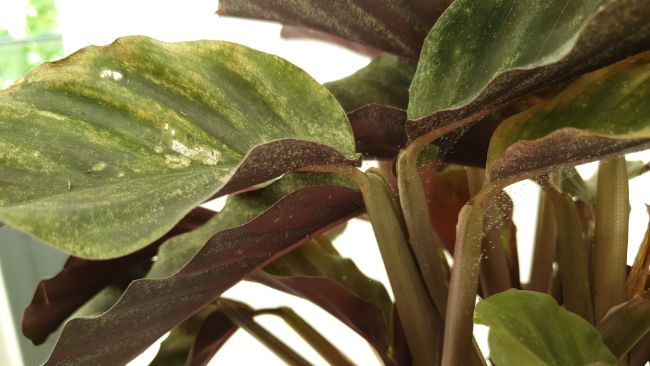
How to Fix A Calathea Dying Due To Pests
I always advise checking your plants closely when you water them for any signs of pests. The most important thing to do if you spot any pests is to immediately quarantine the affected plant from your other houseplants. Pests can spread quickly. One plant with pests is annoying, but an infestation affecting your whole collection is a disaster.
Once quarantined, you have several treatment options. The first thing I like to do is to either wipe off as many pests as possible or use a tap or showerhead to manually remove as many pests as I can.
After this, I prefer to use one of the following treatments; (links to Amazon)
- A dilute neem oil spray applied at weekly intervals.
- Isopropyl alcohol sprayed or wiped all over the plant at weekly intervals.
- Use a horticultural oil spray all over the plant at weekly intervals.
I prefer to use these treatments for a minimum of four weeks and look closely for any sign of pests to ensure the infestation has been successfully dealt with.
Once you are sure the plant is free of pests, you can bring it back into contact with other plants.
Avoid pruning damaged leaves excessively at this time, as it will simply cause more stress for your plant. Prune off any completely or largely dead leaves, but leave lightly damaged ones for now.
Once your plant has plenty of new, healthy growth, you can safely prune off the remainder of the damaged leaves.
3. Low Humidity
While overwatering and pests can result in your Calathea dying very quickly, low humidity causes a slower decline that will eventually result in the demise of your once-beautiful plant. Calatheas simply can’t cope with humidity below 40%, and some show some signs of damage below 60% humidity.
If your Calathea is developing brown leaf edges and brown tips, that are slowly getting worse over time and spreading to more and more leaves, low humidity is the likely culprit.
If your Calathea is kept in low humidity conditions for long enough, the leaves will become browner and browner, before dying, and it is possible your plant may die completely.
How To Fix A Calathea Dying Due To Low Humidity
The first part of the puzzle is to know what the humidity levels are in your home. I would highly recommend getting a digital humidity meter/hygrometer if you are growing houseplants that are sensitive to humidity levels. This is the humidity meter I use.
The second issue is how to get humidity levels up to a suitable level. Here are a few options that work well.
- Keep your houseplants grouped together. The collective evaporation and transpiration will increase local humidity for all your plants.
- Use a humidity tray – a shallow tray of water situated beside or underneath your plant. This will increase local humidity due to the increased evaporation of water into the air.
- I find the best, and easiest way to increase humidity for my Calatheas is to use a humidifier. This is the one I use. It has a large water tank and you can control the humidity target, making it really easy to keep your plants happy.
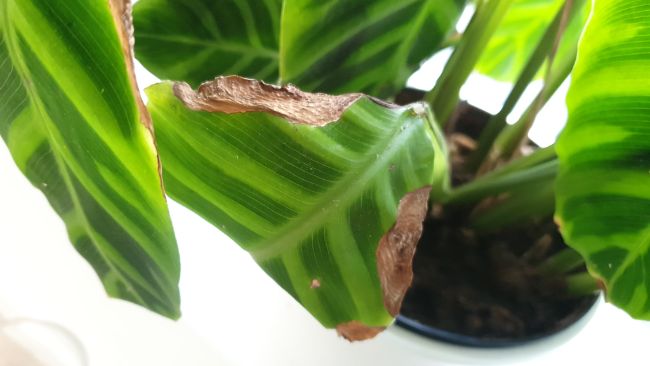
4. Temperature Stress
If your Calathea is getting brown leaf edges or tips or is wilting despite having its other needs met, consider temperature stress as a potential cause.
Calatheas are used to very consistent temperatures in their natural habitat, and for this reason, they don’t cope well with temperature extremes or fluctuations.
Calatheas are happiest when kept in temperatures of 64ºF (18ºC) to 75ºF (24°C). They can handle warmer temperatures as long as humidity is kept high and they avoid drying out.
However, avoid temperatures below 60°F (15°C), as anything lower than this will start causing considerable stress for your plant, and temperatures of only 50°F (10°C) or below can result in a Calathea dying.
You should also be very cautious of drafts from windows or doors, air conditioning vents, radiators, or other heat sources. These cause large temperature fluctuations and can cause a rapid deterioration in the condition of your plant, leading to brown or yellow leaves, wilting, and even the death of your Calathea.
How To Fix A Calathea Dying Due To Temperature Stress
Buying your plant from the store or having it delivered is a very common time for your Calathea to experience acute temperature stress. Try to control the temperature your Calathea is exposed to on the ride home, and try to get it home and into a suitable location as soon as possible.
Before putting your plant in position, think about all the sources of potential hot or cold stress. Place your plant somewhere that it will get reasonably consistent temperatures.
Use a thermometer to monitor the temperature in the location where you place your Calathea. The digital hygrometer/thermometer I mentioned previously will also monitor current, maximum and minimum temperatures, making this an essential tool.
If you notice that the plant is being exposed to extremes of heat or cold, you will be able to move your plant before any major damage is done.
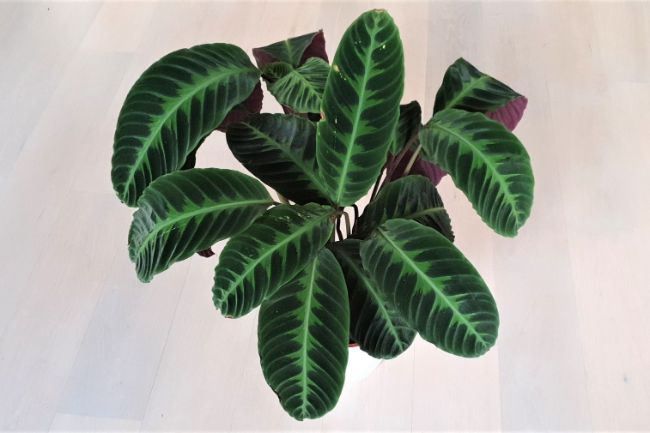
5. Underwatering
Whilst overwatering is a more common cause of a Calathea dying, you also need to watch out for underwatering. This is much easier to identify, as you will be greeted by a wilting plant and the soil will feel dry to the touch.
Severe or repeated underwatering can easily result in your Calathea dying, but will certainly result in damaged foliage over time.
Bear in mind that there are several factors that will cause your Calathea to use water more quickly, or be more prone to wilting or dying due to lack of water;
- Becoming rootbound – A rootbound Calathea will fill the entire pot and will need to be watered frequently to prevent it from wilting. This is a good time to repot your Calathea into a larger container.
- Hot weather – If temperatures are consistently high, there will be increased evaporation of water from the soil and transpiration from the leaves.
- Not watering properly – It’s important to soak the soil and rootball when watering to ensure your plant gets a proper drink.
How To Fix A Calathea Dying Due To Underwatering
The good news is that a Calathea that wilts occasionally due to underwatering will recover very nicely after watering with minimal damage.
It is only prolonged or repeated underwatering that will cause major problems or result in your Calathea dying. The best advice I have is to simply get into the routine of checking on your plants every 2-3 days.
Look at the foliage and feel the soil. Poke a finger into the soil to feel how dry it is. Once the top inch of soil feels dry, it’s definitely time to water your Calathea.
Water thoroughly each time, making sure to drain any excess water to avoid the roots sitting in waterlogged soil. You can follow the advice in the video below to learn how I water my plants.
6. Incorrect Lighting
Another reasonably common cause of a Calathea dying is incorrect lighting. Excess light will cause your plant to die quicker, but low light can be equally deadly for a Calathea.
Excess Light
Your Calathea should not receive any significant direct sunlight. They prefer bright, indirect light.
Excess direct sunlight will cause leaf scorching, rapid leaf dehydration, brown edges, and the death of entire leaves. This can happen over as little as a few days, so be careful where you put your Calathea.
Bear in mind that lighting in a room can change dramatically depending on the season and the weather. You may need to move your Calathea during the year to maintain optimal lighting.
Where I live, I can place my Calatheas in a south-west facing window in winter and this will provide perfect lighting. However, in summer, my poor plants would be scorched to death in this location.
Low Light
Although low light won’t kill your plant immediately, or even directly, it is a sure-fire way to kill your Calathea in the long term. Low light results in slow growth and makes the risk of overwatering and root rot excessively high.
A Calathea placed in a dark corner will use very little water, so even if you water lightly, the soil may get soggy over time, or dry out so slowly that root rot is inevitable.
Most Calatheas do best when they are placed in the brightest spot in a room that doesn’t get any direct sunlight. Read my article about light levels for houseplants to find out what bright, indirect light really means.
You can download a light meter app for your phone – just search your phone’s app store for “light meter app” – and you will find plenty. You will be surprised by just how bright the lighting should be for houseplants to grow at their best.
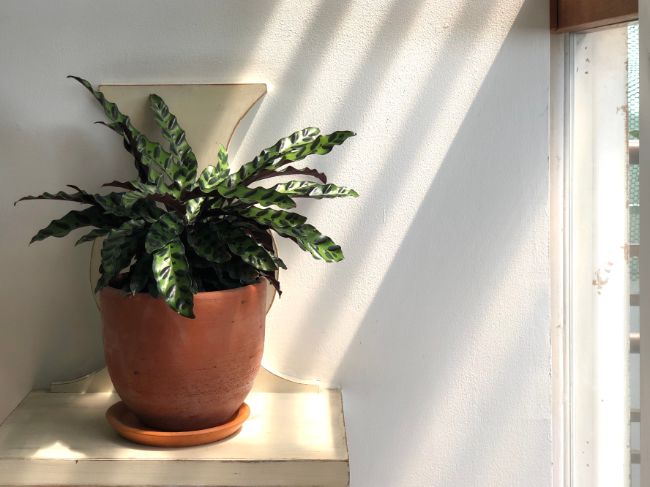
7. Transplant Shock
One self-inflicted cause of a Calathea dying is transplant stress. Calatheas are really sensitive houseplants, and they hate having their roots disturbed unnecessarily.
If your Calathea starts wilting dramatically within the first few days after repotting, then transplant shock is the likely cause. In this situation, the roots temporarily cease functioning, and the plant becomes dehydrated due to lack of water.
How To Prevent A Calathea Dying Due To Transplant Shock
I’ve written an entire article about how to repot Calatheas safely. The main advice is to avoid repotting your Calathea until it is showing signs of becoming rootbound. When you do repot your Calathea, avoid disrupting the rootball unless absolutely necessary.
Just increase the size of the pot by 1-2 inches (2.5-5cm diameter) and add extra soil around the existing rootball.
If your Calathea is currently suffering from transplant shock, then reducing water loss while the roots recover is the most important action. Increase humidity as much as possible, avoid excessively high temperatures or lighting, and reduce the temperature around your plant to the lower end of its normal range.
This will buy your plant time for the roots to recover. Calatheas don’t always recover from transplant shock, but these simple measures will greatly increase the chances of survival.
8. Disease
The most common group of diseases that Calatheas suffer from is those that cause root rot. This can be devastating, and should be treated as outlined earlier in this article. I have also written a separate article about treating and preventing root rot.
Less commonly, Calatheas can get leaf blight diseases, caused by a range of fungal and bacterial pathogens. This usually results in multiple black or brown spots on the leaves that spread over time, and can quite quickly result in your Calathea dying.
Prompt action is required to deal with any Calathea diseases. Leaf blight should be treated by pruning off all affected foliage immediately and isolating your plant from any other houseplants.
Topical treatments for leaf spot diseases are rarely effective for Calatheas. Success depends on how quickly the affected foliage is removed and how severe the disease outbreak has been.
Last Word
Whilst there are plenty of challenges that come with keeping Calatheas (Goeppertias) healthy, they are such beautiful houseplants that are definitely worth the effort required to keep them in good condition.
If you keep a close eye on your Calatheas, and think carefully about any problems that arise, I believe you can identify and fix most problems long before they result in your Calathea dying.
If you’re having any other specific problems with your Calatheas, or simply want to learn more about keeping them healthy, you can check out some of the following articles I have written.
- How to repot a Calathea
- Why do Calathea leaves turn yellow, and how do I fix them?
- Causes of curling leaves on Calathea houseplants
- How to care for Calathea ornata
- How to care for Calathea warscewiczii
- How to care for Calathea zebrina
- How to propagate Calatheas
- How to identify, treat, and prevent common houseplant pests
- 12 stunning Calathea varieties you will love
- Check out my book, “Houseplants Made Easy”

